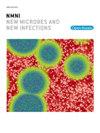欧洲献血者中蜱传感染的血清流行率:一项系统回顾
IF 5.4
Q2 INFECTIOUS DISEASES
引用次数: 0
摘要
蜱传感染对公共卫生构成越来越大的威胁,最近的研究表明,通过蜱叮咬传播给人类的感染范围很广。这种情况可能对输血传播的tbi的血液安全产生影响。我们的目的是评估2000年至2024年欧洲献血者中tbi的血清患病率。方法本系统评价遵循PRISMA指南。我们使用与tbi、欧洲和流行病学相关的关键词检索了PubMed、Embase、MEDLINE、Scopus、CINAHL和截至2024年4月的国家报告系统。两名审稿人独立筛选和选择研究,重点关注2000年至2024年欧洲献血者tbi的血清患病率。进行数据提取和偏倚风险评估。结果共检索到文献5304篇,其中符合纳入标准的文献56篇。我们在引文检索后添加了一篇文章。纳入的研究包括19个欧洲国家和11个不同的tbi。研究最多的病原体是伯氏疏螺旋体,大多数研究采用抗体检测作为诊断技术。蜱传脑炎病毒(TBEV)、巴尔通体、立克次体和伯氏疏螺旋体的血清阳性率最高,在一些研究中,病原体血清阳性率超过20%,这取决于病原体和所纳入个体的疫苗接种状况。结论本研究强调需要关注更广泛的蜱传病原体,以更好地了解tbi的流行病学格局。此外,结合捐献血液的核酸扩增检测将提高区分过去接触和潜在传染性的能力,从而改进输血医学中对创伤性脑损伤传播风险的评估。本文章由计算机程序翻译,如有差异,请以英文原文为准。
Seroprevalence of tick-borne infections in blood donors in Europe: a systematic review
Background
Tick-borne infections (TBIs) pose an increasing threat to public health and recent research shows a wide range of infections transmitted to humans by tick bite. This situation may have an impact on blood safety in the context of transfusion-transmitted TBIs. We aimed to assess the seroprevalence of TBIs in blood donors in Europe in the period 2000 to 2024.
Methods
This systematic review followed PRISMA guidelines. We searched PubMed, Embase, MEDLINE, Scopus, CINAHL, and national reporting systems up to April 2024 using keywords related to TBIs, Europe and epidemiology. Two reviewers independently screened and selected studies, focusing on seroprevalence of TBIs in European blood donors from 2000 to 2024. Data extraction and risk of bias assessment were performed.
Results
The search yielded 5304 articles, of which 56 met the inclusion criteria. We added one article after citation search. The included studies encompassed 19 European countries and 11 different TBIs. The most studied pathogen was Borrelia spp. The majority of studies used antibody detection as a diagnostic technique. The highest seroprevalence rates were observed for Tick-Borne Encephalitis Virus (TBEV), Bartonella spp., Rickettsia spp. and Borrelia spp. with pathogen seropositivity rates, in some studies, of over 20 % depending on the pathogen and the vaccination status of included individuals.
Conclusions
This study highlights the need to focus on a wider range of tick-borne pathogens to better understand the epidemiological landscape of TBIs. Additionally, incorporating Nucleic Acid Amplification Testing of donated blood will improve the ability to differentiate between past exposure and potential infectivity, to allow for an improved assessment of TBI transmission risk in transfusion medicine.
求助全文
通过发布文献求助,成功后即可免费获取论文全文。
去求助
来源期刊

New Microbes and New Infections
Medicine-Infectious Diseases
CiteScore
10.00
自引率
2.50%
发文量
91
审稿时长
114 days
 求助内容:
求助内容: 应助结果提醒方式:
应助结果提醒方式:


